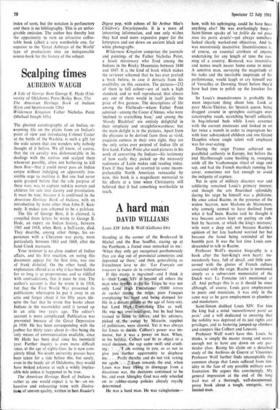Stored hoards
MICHAEL BORRIE
The Museum Age Germain Bazin (Desoer/ Literary Services and Production 7 gns)
Why is 'museum,' like 'amateur,' becoming a term of deriSion among those who 'should know better? Has the museum" as we know it any future? What should it be doing? Anxious museologists la horrible but serviceable word) everywhere are asking themselves such ques- tions. And so they should, for the time is surely coming when Jerusalem will be searched with lighted candles, and these great monu7 meets of -western civilisation will have to justify themselves to a public opinion in- different or hostile to the classical, humanist tradition that has made them what they are.
M Bazin, Professor of Museology at the Ecole du Louvre, has thus produced his book at a most opportune moment. It is a brilliant essay on the idea of a museum; traced from its inception in ancient Greece to its revival
in the Renaissance as the princely private cabinet of works of art and precious objects, and its transformation by way of the quasi- public private museums of the Enlightenment into the publicly sponsored institutions familiar today. The 'Museum Age' has been a long one. For 500 years the mania for collecting art treasures
has continued unabated. Much of M Bazin's book is necessarily a history of private collect- ing. He discusses at length the development
of the art trade in the seventeenth century by
such figures as Daniel Nys, the Duveen of his day, the prototype 'big deal' entrepreneur who negotiated the sale of the fabled Gonzaga
Cabinet to Charles I. There is much in this to entertain and amuse the ordinary reader. The
author has a large fund of anecdotes about the murkier reaches of the art trade, ranging from the straightforward embezzlement of Andrea
del Sarto who, sent to Rome by Francis I to buy antiquities, simply pocketed the cash and never came back, to the more sophisticated mutual swindling practised by Sir Dudley Carleton, British Ambassador at the Hague, and Rubens. Carleton persuaded Rubens to part with eighteen of his paintings in exchange for some mediocre antiquities; Rubens included several works by his pupils in the consignment, and then unloaded the antiquities on the Duke of Buckingham for a handsome sum. And on the subject of exchanges, one learns with fascination that Frederick William I swapped. a cabinet of Baltic amber with Catherine 11 for one hundred six-foot-six Grenadiers.
Forgery supplied what the genuine market lacked. Sebastien Bourdon manufactured Pous-. sins and Le Nains. Luca Giordano turned out Guido Renis, Tintorettos, Raphaels, Caravag- gios and Rembrandts. In the sixteenth century Tartaglio did a brisk trade in home-made monsters such as hydras and cockatrices for modish cabinets of curiosities.
There is a vast amount of information about the development of modern public museums and the ideas and social pressures that have shaped them. The story is carried down to the new museum of Jerusalem, the latest large museum to be opened. The author has little liking for currently fashionable methods of display, and the vogue for 'period rooms' so much in favour in America. His greatest praise is, however, reserved for the American museum system for its freedom from state con- trol and its responsive dependence on the direct patronage of the people who use it. On the future of museums in general he inclines to be gloomy. He contemplates with distaste the possibility of a 'world demolished by six billion insects and a scattering of museums where the imprisoned remains of the world's beauty slowly perish.' On the immediate future he is rather more optimistic, seeing in the ex- pansion of museums' educational activities a return to the Greek ideals which will bring at least temporary salvation.
The book is attractively designed and the colour plates are good. The illustrations include some splendid curiosities, such as the free- standing refreshment room erected for the V and A in 1865, in appearance a sort of half- timbered mediaeval engine-shed of indeter- minate date, with the breathtaking caption, `Since the nineteenth century, Anglo-Saxon museums have concerned themselves with the comfort of visitors.'
Enjoyable as the book is, there are some serious criticisms to be made of it. The style is diffuse and repetitive, and M Bazin has been ill-served by his translator, who has simply given a literal rendering into English, sometimes with bizarre effect. He is a master of his subject and his book is a mine of useful information. It is a pity, therefore, that he rarely tells us where he got it. There is an index of sorts, but the notation is perfunctory and there is no bibliography. This is an unfor- givable omission. The author has thereby lost the opportunity to turn an attractive coffee- table book (albeit a very worthwhile one, far superior to the 'Great Ashtrays of the World' type of production) into an indispensable source-book for the history of the subject.







































 Previous page
Previous page